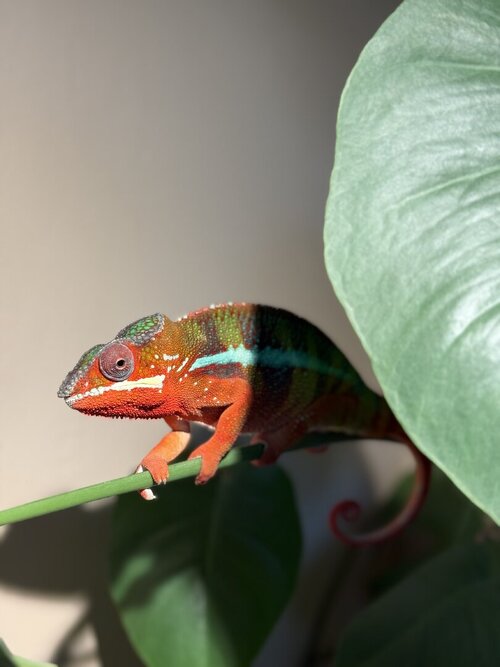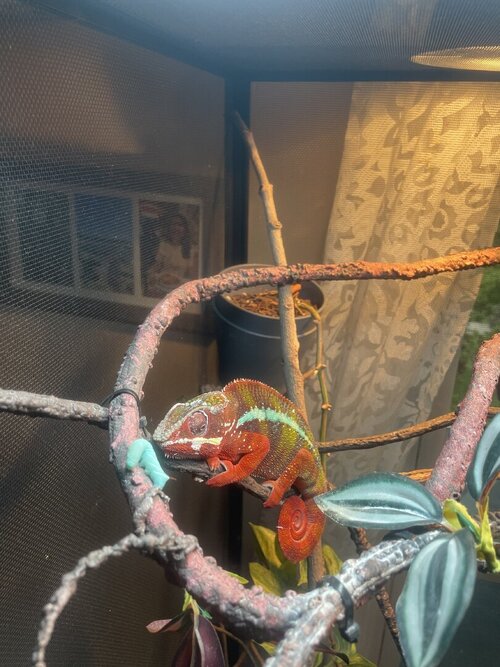zukothechameleon
New Member
Hi, I have a male panther, about 1.5 years old who we've owned for over a year. He's suffering from dehydration, I believe. He had his annual vet check up 3 weeks ago and came back in great shape no parasites. However, while on vacation the sitter noted he stopped eating and was in the middle of a shed, which isn't abnormal for him to skip a meal for 2-3 days. We sent him some crickets which he rarely turns down. However, by a later check in picture his eyes were showing slightly sunken so had her mist him each day. Returned to eyes very sunken and him asleep during the afternoon. It turns out the automatic sprayer stopped working and he's dehydrated. The first evening back I gave him a shower and he drank steadily for 45 minutes. I added a mechanical dripper he slept under. Yesterday, I was hoping he'd recover some, increased humidity, had a constant drip in the corner of the cage and the sprayer was back to working. He was looking alright early in the day, some calm colors back and eyes alert, but by afternoon had progressed to sleep colors while awake a little and sleeping by 3-4 hours ahead of when he normally tucks in. Eyes didn't seem to improve ultimately. I got him to drink 1.5 ML of pedialyte before he slept. Also, waiting on the vet since yesterday to try to squeeze him in. Two photos are attached of him content from a few weeks ago and onset of sunken eyes from Friday. He is still shedding his face.
Cage Info:
- Your Chameleon
1.5 year old panther, male. - Handling - How often do you handle your chameleon?
If he climbs out while trying to feed him, which happens once to twice a week. - Feeding - What are you feeding your cham? What amount? What is the schedule? How are you gut-loading your feeders?
At this point, once a day, a combo of silk worms, horn worms, black soldier fly larvae, superworms, crickets. Silk worms and crickets are the staples. He hates dubia. - Supplements - What brand and type of calcium and vitamin products are you dusting your feeders with and what is the schedule?
Multivitamin and Calcium with D3 twice a month, calcium every feeding (Except black soldier fly larvae) - Watering - What kind of watering technique do you use? How often and how long to you mist? Do you see your chameleon drinking?
Automatic mister at lights on and right before lights out, and fogger/humidifier always keeping it 60-80. - Fecal Description - Briefly note colors and consistency from recent droppings. Has this chameleon ever been tested for parasites?
Until the last few days, great. After drinking a ton on our return he has pooped, twice, both mostly water. - History - Any previous information about your cham that might be useful to others when trying to help you.
From a reputable, small breeder.
Cage Info:
- Cage Type - Describe your cage (Glass, Screen, Combo?) What are the dimensions?
2x2x4 reptibreeze screen cage.
Lighting - What brand, model, and types of lighting are you using? What is your daily lighting schedule?
-Zoo Med ReptiSun 5.0 HO linear T5 UVB Lamp 22" 24 Watts
-ZooMed 75 watt Repti Basking Spot Lamp, SL-25 for basking, 2nd incandescent, 50 watts farther from the cage to have half of the top reach appropriate basking temperature.
These are on for around 12 hours a day, and off the other 12 hours. - Temperature - What temp range have you created (cage floor to basking spot)? Lowest overnight temp? How do you measure these temps?
Temperatures in the basking zone sit around 80-85. Lower cage is 75 during the day, drops to 65-70 at night. I measure temps with thermometer guns and one thermometer/humidity reader next to the cage. - Humidity - What are your humidity levels? How are you creating and maintaining these levels? What do you use to measure humidity?
Day time ~60%%. At night spikes to 80% and then drops back to 60% by morning. - Plants - Are you using live plants? If so, what kind?
1 pothos, 1 larger ficus, 1 snake plant. - Placement - Where is your cage located? Is it near any fans, air vents, or high traffic areas? At what height is the top of the cage relative to your room floor? The cage is near a window and has an A/C nearby. It is kept on a table 3 feet off the ground. The top of the cage is about 2 feet from the ceiling.
- Location - Where are you geographically located?
Maryland







